As I sat down with a steaming bowl of Creamy Gochujang Udon Noodles, the intoxicating aroma of garlic and ginger filled the room, transporting me straight to a bustling Seoul noodle shop. This delightful dish is perfect for those evenings when time is tight, yet you crave something special and flavorful. In just 25 minutes, you can whip up a luscious, vegetarian-friendly meal that not only satisfies your taste buds but can also be easily customized to include your favorite proteins. Whether you’re cooking for family or just treating yourself after a long day, these udon noodles offer a quick escape from the ordinary. Ready to dive into this culinary adventure and discover a new weeknight favorite?

Why are these noodles a must-try?
Quick and Easy: This recipe comes together in just 25 minutes, making it ideal for busy weeknights when you need a delicious dinner without the fuss.
Flavor Explosion: The blend of gochujang, peanut butter, and fresh veggies creates a mouthwatering combination that packs a punch with every bite.
Vegetarian-Friendly: Perfect for those looking to enjoy a meatless meal that doesn’t skimp on taste—feel free to customize with your favorite protein!
Versatile Ingredients: You can easily substitute ingredients like udon noodles and vegetables based on what you have on hand, making it a go-to recipe for all pantry staples.
Crowd-Pleasing Dish: Impress your family or guests with a restaurant-quality meal that looks and tastes amazing, without spending hours in the kitchen.
Make Ahead: For even easier meal prep, consider making the sauce ahead of time and storing it in the fridge—ready to toss with noodles whenever you crave a cozy bowl of goodness!
Creamy Gochujang Udon Noodles Ingredients
Dive into the delightful flavors with these simple ingredients!
For the Noodles
- Udon Noodles – The essential base providing heartiness; can swap with rice noodles for a gluten-free twist.
For the Sauce
- Gochujang – The star ingredient for spice and depth; it brings authentic Korean flavor to your Creamy Gochujang Udon Noodles.
- Creamy Peanut Butter – Adds a rich, smooth texture; substitute with almond butter for a nut-free version.
- Soy Sauce – Provides umami; tamari is a great gluten-free alternative.
- Rice Vinegar – Introduces acidity; apple cider vinegar works well in its place.
- Honey or Maple Syrup – Adds sweetness; for strict vegetarians, opt for maple syrup.
- Coconut Milk – Contributes creaminess; heavy cream or dairy-free alternatives can be used instead.
For the Veggies
- Vegetable Oil – Used for sautéing; feel free to use olive oil instead.
- Garlic (3 cloves, minced) – Elevates the dish with aromatic flavor; fresh will always be best!
- Fresh Ginger (1 tsp, grated) – Infuses a warming zing; you can use frozen ginger for convenience.
- Broccoli (1 cup, florets) – Adds texture and nutrition; swap with green beans if desired.
- Bell Peppers (1 cup, sliced) – Brings color and sweetness; any bell pepper variety works!
- Snap Peas (1 cup) – Offers a sweet crunch; can be replaced with snow peas or omitted if necessary.
For Garnishing
- Green Onions (for garnish) – Adds freshness; can be replaced with chives for a different flavor.
- Sesame Seeds (for garnish) – Enhances presentation and flavor; sprinkle on top for that extra crunch!
Now that you have all the goodies lined up, let’s get cooking this easy and engaging Creamy Gochujang Udon Noodles!
Step‑by‑Step Instructions for Creamy Gochujang Udon Noodles
Step 1: Cook the Udon Noodles
Begin by bringing a large pot of water to a rolling boil over high heat. Once boiling, add your udon noodles and cook according to the package instructions, typically for 8-10 minutes. Stir occasionally to prevent sticking. When the noodles are tender yet still have a slight bite (al dente), drain them in a colander and set aside while you prepare the sauce.
Step 2: Sauté Aromatics
In a large skillet or wok, heat 2 tablespoons of vegetable oil over medium heat. Once the oil is shimmering, add the minced garlic and grated ginger, sautéing for about 1 minute until fragrant but not burnt. This step adds a flavorful base for your Creamy Gochujang Udon Noodles, so watch closely for that aromatic moment before moving to the next step.
Step 3: Stir-Fry Vegetables
Add the broccoli florets, sliced bell peppers, and snap peas to the skillet. Stir-fry these vibrant vegetables for 5-7 minutes, until they are tender-crisp and full of color. Toss them frequently to ensure even cooking and keep an eye on them; they should be vibrant and slightly soft but still retain their crunch for the perfect texture in your udon dish.
Step 4: Whisk the Sauce
While the veggies are cooking, prepare the creamy sauce in a separate bowl. Whisk together the gochujang, peanut butter, soy sauce, rice vinegar, honey (or maple syrup), and coconut milk until smooth and well-combined. This delightful mixture will bring a rich and spicy flavor to your Creamy Gochujang Udon Noodles, so ensure it's thoroughly blended.
Step 5: Combine Sauce and Noodles
Pour the whisked sauce over the sautéed vegetables in the skillet, ensuring everything gets coated evenly. Gently add the drained udon noodles to the skillet, using tongs or a large spoon to carefully toss the noodles with the vegetables and sauce. Stir well for about 1-2 minutes, letting the noodles soak in all those delicious flavors.
Step 6: Heat and Serve
Continue cooking the mixture for another 2-3 minutes, stirring constantly until everything is heated through and nicely combined. As the noodles warm, they will absorb the sauce, creating a luscious dish. Taste to adjust seasoning if needed, then serve hot, garnished with sliced green onions and a sprinkle of sesame seeds for that extra touch of flavor and presentation.

What to Serve with Creamy Gochujang Udon Noodles
As you savor every bite of your Creamy Gochujang Udon Noodles, consider these delightful pairings that elevate your meal experience.
- Crispy Tofu: Offers a delightful crunch and a source of protein, complementing the creamy noodles beautifully.
- Pickled Vegetables: The tangy bite of pickled radishes or cucumbers adds a refreshing contrast to the rich, savory sauce.
- Steamed Broccoli: A simple yet nutritious side that echoes the flavors of the udon while enhancing the meal's colors.
- Sesame Spinach Salad: The nutty flavors and crisp texture create a perfect balance with the creamy noodles; a light side that’s still hearty.
- Kimchi: This spicy, fermented dish not only adds a kick but also enhances the overall flavor profile with its tang and depth.
- Spicy Edamame: A fun finger food for a crunchy, snackable side that meshes well with the umami richness of the noodles.
- Sushi Rolls: Bite-sized sushi brings a diverse flavor experience and texture; ideal for a celebratory or special occasion meal.
- Fruit-Infused Iced Tea: Refreshing and subtly sweet, this drink complements the spiciness of the noodles while cleansing your palate.
How to Store and Freeze Creamy Gochujang Udon Noodles
Fridge: Store leftover Creamy Gochujang Udon Noodles in an airtight container for up to 3 days. This helps maintain their flavor and texture.
Freezer: For longer storage, freeze the dish in an airtight container for up to 2 months. However, note that the texture of the vegetables may change upon thawing.
Reheating: When ready to enjoy, thaw in the fridge overnight, then reheat on the stovetop over low heat. Add a splash of coconut milk to restore creaminess while heating.
Make-Ahead: Prepare the sauce and noodles separately and store in the fridge for easy reheating, making this meal a convenient option for busy days.
Tips for the Best Creamy Gochujang Udon Noodles
• Perfect Noodle Texture: Avoid overcooking the udon noodles; they should be al dente for the best texture. Drain immediately to prevent further cooking.
• Flavor Control: Taste as you go—adjust the amount of gochujang based on your spice preference. Start with less if you're unsure!
• Crisp Vegetables: Stir-fry veggies just until tender-crisp to maintain their vibrant color and crunch. No one likes soggy veggies!
• Avoid Clumping: Toss noodles with sauce and vegetables gently to ensure every strand is coated without breaking—this keeps the dish visually appealing.
• Storage Secrets: Leftovers can be stored in an airtight container for up to three days. Reheat with a splash of coconut milk to restore creaminess.
Make Ahead Options
These Creamy Gochujang Udon Noodles are fantastic for meal prep, saving you precious time during busy weeknights! You can prepare the sauce up to 3 days in advance, storing it in an airtight container in the refrigerator to maintain its vibrant flavors. Additionally, you can chop the vegetables and refrigerate them the night before, which helps to keep them fresh. When you're ready to enjoy your noodles, simply cook the udon noodles according to package instructions, toss everything in a skillet with the prepped sauce and vegetables, and heat it all together for about 5 minutes. This method ensures your meal is just as delicious as if you had made it from scratch right before serving!
Creamy Gochujang Udon Noodles Variations
Feel free to explore these delightful twists that elevate the essence of your Creamy Gochujang Udon Noodles!
- Protein-Packed: Add cooked chicken, shrimp, or tofu during the last mixing step for extra heartiness and protein. Each addition brings unique flavors that harmonize effortlessly with the silky noodles.
- Veggie Boost: Incorporate more vegetables like spinach, mushrooms, or carrots for added nutrition and vibrant color. This not only enhances the dish’s appeal but also creates a satisfying meal that feels wholesome.
- Extra Creaminess: Increase the coconut milk quantity for a richer sauce that envelops the noodles beautifully. This creamy touch transforms an already luscious dish into an indulgent experience.
- Spice it Up: For those who crave heat, add a dash of sriracha or red pepper flakes to the sauce for an extra kick. Adjust according to your taste preference while still enjoying the comforting undertones.
- Zesty Twist: Squeeze fresh lime juice over the dish just before serving to brighten the flavors and add a refreshing zing. A simple addition that elevates the dish and creates a wonderful contrast.
- Nut-Free Alternative: Swap creamy peanut butter with sunflower seed butter for a nut-free variation that still delivers a smooth finish. Perfect for families with nut allergies while keeping the creaminess intact!
- Gluten-Free Version: Substitute udon noodles with rice noodles or zucchini noodles for a gluten-free option that doesn’t compromise on flavors. Zucchini noodles add a light freshness that complements the richness of the sauce.
- Umami Amplification: Experiment with adding a tablespoon of miso paste to the sauce for an even deeper umami flavor that enhances the overall taste profile. It’s a simple yet effective twist that brings the dish to another level.
Feel inspired to mix and match these delightful variations, and let your culinary creativity shine!

Creamy Gochujang Udon Noodles Recipe FAQs
What type of udon noodles should I use?
You can use fresh or dried udon noodles for this recipe. Fresh udon typically cooks faster, around 3-5 minutes, while dried noodles take about 8-10 minutes. If you’re looking for a gluten-free option, swap udon for rice noodles instead!
How should I store leftover creamy gochujang udon noodles?
Leftovers can be kept in an airtight container in the refrigerator for up to 3 days. This helps maintain their flavor and texture. To reheat, simply warm them on the stovetop over low heat, adding a splash of coconut milk to bring back some of that creamy goodness.
Can I freeze creamy gochujang udon noodles?
Absolutely! You can freeze the noodles for up to 2 months in an airtight container. When you’re ready to enjoy, thaw them in the fridge overnight, and reheat on the stovetop. Keep in mind that the texture of the vegetables might change after freezing, so you may want to add fresh veggies the next time you cook them!
What if my sauce is too thick?
If you find your sauce is too thick, don't fret! Just add a little more coconut milk or water—start with a tablespoon or two and stir until you reach your desired consistency. This will help keep your creamy gochujang udon noodles luscious and enjoyable.
Is there a protein I can add to this dish?
Yes, you can easily customize this dish! Feel free to add cooked protein like chicken, shrimp, or tofu during the last mixing step. Just make sure to heat it through with the sautéed veggies and sauce for an all-in-one meal packed with flavor and nutrients.
Can I make this recipe vegan-friendly?
Absolutely! To keep the creamy gochujang udon noodles vegan, simply use maple syrup instead of honey, and ensure that all your sauces are plant-based. The creamy peanut butter and coconut milk contribute a delightful richness without any animal products—making it a fantastic vegetarian-friendly option.
Enjoy experimenting with these FAQs as you whip up your tasty udon noodles!
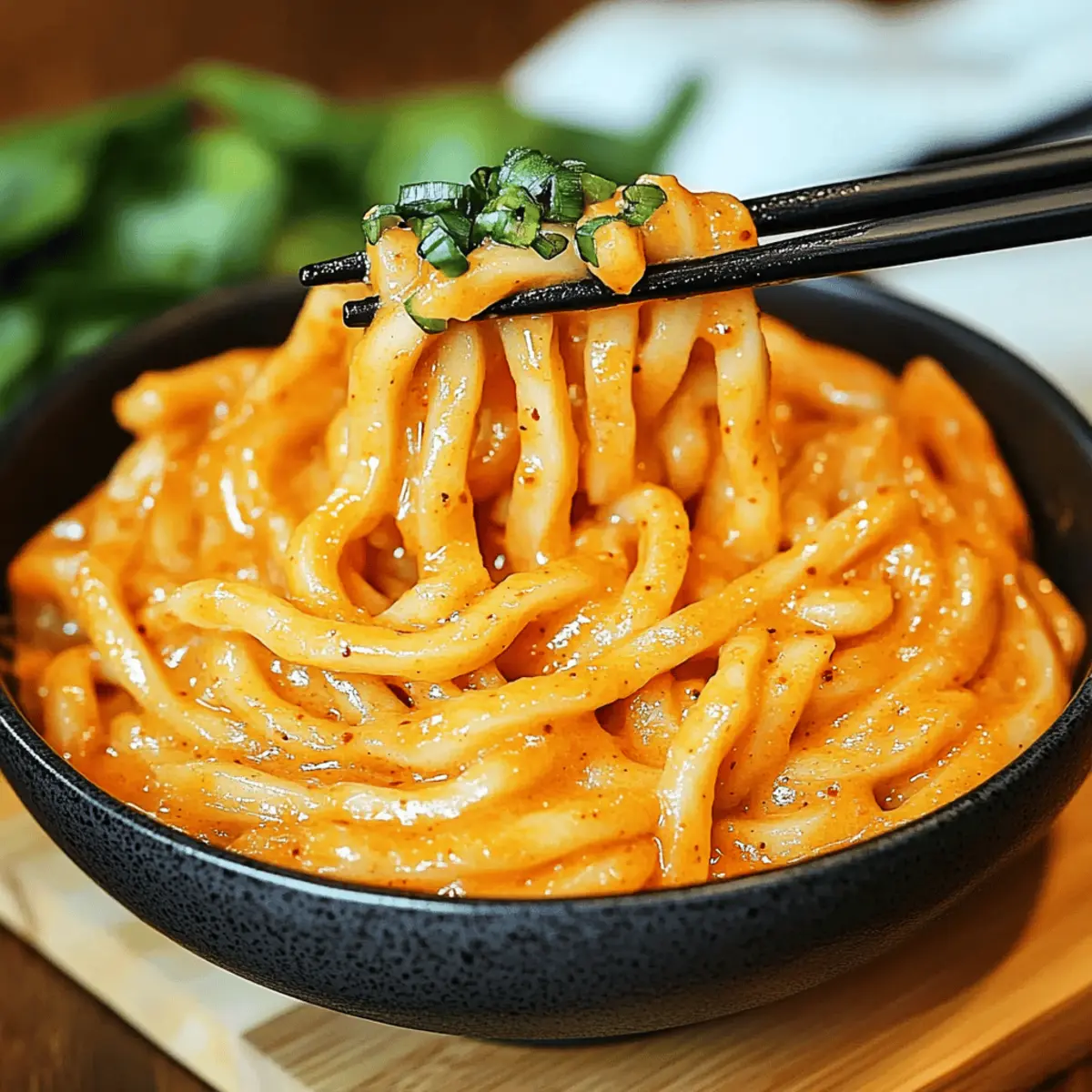
Indulgent Creamy Gochujang Udon Noodles Ready in 25 Minutes
Ingredients
Equipment
Method
- Cook the Udon Noodles: Bring a large pot of water to a rolling boil, add udon noodles, and cook according to package instructions for 8-10 minutes, then drain and set aside.
- Sauté Aromatics: Heat vegetable oil over medium heat, add minced garlic and grated ginger, and sauté for about 1 minute until fragrant.
- Stir-Fry Vegetables: Add broccoli, bell peppers, and snap peas, stir-fry for 5-7 minutes until tender-crisp.
- Whisk the Sauce: In a separate bowl, whisk together gochujang, peanut butter, soy sauce, rice vinegar, honey (or maple syrup), and coconut milk until smooth.
- Combine Sauce and Noodles: Pour the sauce over the sautéed vegetables and gently toss in the drained udon noodles.
- Heat and Serve: Cook for another 2-3 minutes until heated through, then serve hot garnished with green onions and sesame seeds.

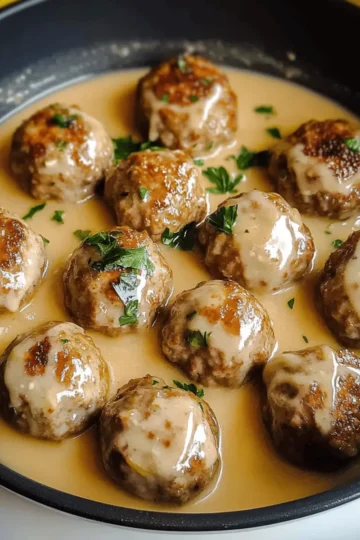
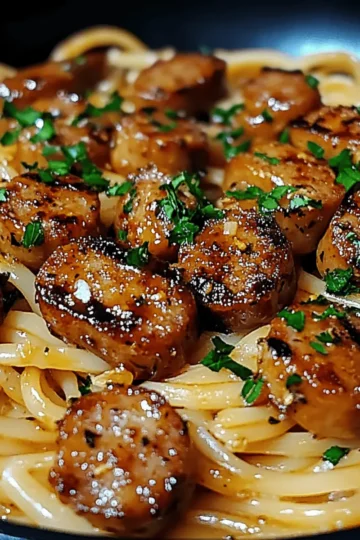
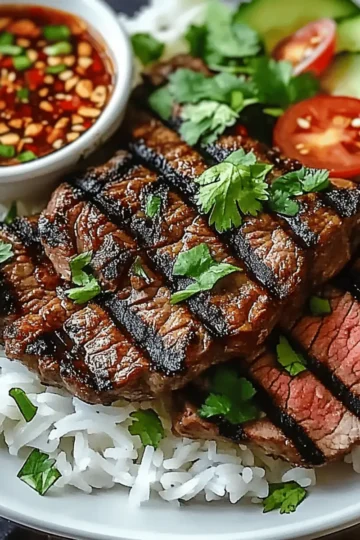
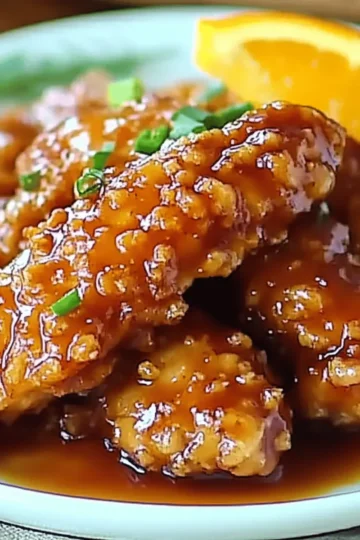
Leave a Reply